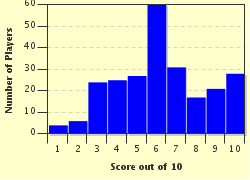Quiz Answer Key and Fun Facts
1. This nursery rhyme is associated with a form of public punishment and humiliation dating right back to the Middle Ages. Can you name it?
2. Performed by many singers in modern times, this sweet old nursery rhyme, in a version performed by Burl Ives, found itself nominated for an Academy Award in 1949. What is it?
3. This nursery rhyme is believed by some to be about Mary Queen of Scots who was hounded by the Protestant reformer, John Knox. Which rhyme is it?
4. This nursery rhyme dates back to an old superstition about bringing good or bad luck upon oneself. What is its name?
5. This old rhyme is based on a true event which took place in Boston in 1830. Can you name it?
6. "London Bridge is Falling Down" is also based on real life events. How was the estuary of England's River Thames crossed before the very first London Bridge was constructed?
7. The old nursery rhyme "A Wise Old Owl" was later used by the US army during the Second World War as a reminder to its soldiers to keep quiet about wartime activities.
8. This nursery rhyme is said to be based on the exploits, or otherwise, of one of England's kings in the events leading up to the 1746 Battle of Culloden. Can you name it?
9. Which of the following nursery rhymes is said to be based on the persecution of Catholic priests during the days of the English 16th century reformation of the church?
10. The most commonly accepted explanation for this nursery rhyme is one based on a form of sport during Elizabethan times. Can you name it?
Source: Author
Creedy
This quiz was reviewed by FunTrivia editor
agony before going online.
Any errors found in FunTrivia content are routinely corrected through our feedback system.

